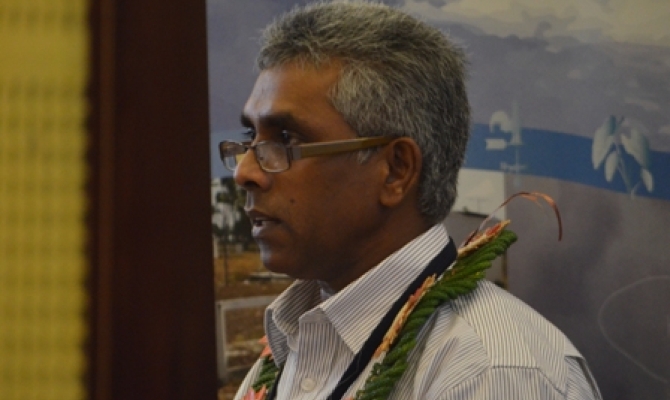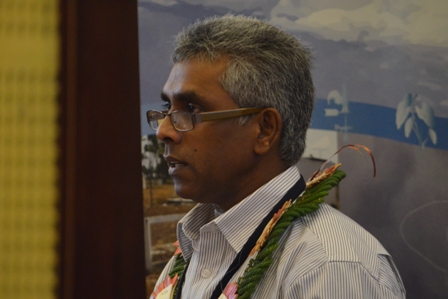
Climate Change Resilience
By Ms. Vuniqaqa Bari-Bola of the Fiji Times
21 July, 2015, Nuku’alofa, Tonga, PMC-3 - FIJI Meteorological Services has set up a Disaster Recovery Centre (DRC) to assist in the continuation of their work should a disaster prevent them from doing so.
With Fiji being home to the Regional Specialised Meteorological Centre, Fiji Met Director Mr. Ravind Kumar said construction work has been completed with skeleton staff working at the centre.
This he revealed to the Fiji Times saying that the DRC would allow members of the public to get forecasts and normal dissemination of information regarding the weather if the FMS office is struck by a disaster in future.
When this occurs, FMS staff in Nadi would be deployed to the Capital City in Suva, said Mr Kumar.
However apart from the Disaster Recovery Centre, Mr Kumar said FMS has also gone out of the way to establish Very High Frequency (VHF) weather reporting stations in remote locations and outer islands.

Mr. Ravin Kumar, Fiji Met Director
“The VHF radios are used as a means of communications from outer islands to communicate weather reports to National Weather Forecasting Centre,” he explained.
He added, “It is primarily for relaying weather reports from the islands. Communities can report any issue to the Centre if all forms of communication to their islands do not work. Officers in Nadi, Nausori and Laucala Bay would then communicate any emergency to the relevant authorities.”
This, Mr Kumar said also assists the region where the regional NMHS (National Meteorological and Hydrological Services) gets the updated weather reports from these islands during the schedule weather recording times in a way of free exchange of weather information on schedule times as per data exchange arrangement with WMO (World Meteorological Organisation) member countries.
The project was part of the Fijian Government’s capital project where the VHF stations were placed on Rotuma, Udu, Nabouwalu, Vanuabalavu, Lakeba, Ono, Matuku, Vunisea, Nadi, Nausori, Laucala, Viwa and Yasawa in Fiji.
With these new setups, the Fiji Met has managed to receive and disseminate “reliable communication system that ensures timely information is available especially during the times of emergencies and severe weather situation.
“This allows reliable and timely forecasts and warnings for all communities in Fiji,” Mr Kumar added. - #PacMC2015
Ms. Vuniwaqa Bari-Bola is a reporter for the Fiji Times - www.fijitimes.com.fj
This article was developed by a Pacific Media Team of Reporters currently providing coverage on the Third Pacific Meteorological Council in Tonga. This activity coordinated by SPREP is supported by a partnership including the Government of Tonga, SPREP, Finland Ministry of Foreign Affairs, Finnish Meteorological Institute (FMI), World Meteorological Organization (WMO) and the Pacific Media Assistance Scheme (PACMAS).
21 July, 2015, Nuku’alofa, Tonga, PMC-3 - FIJI Meteorological Services has set up a Disaster Recovery Centre (DRC) to assist in the continuation of their work should a disaster prevent them from doing so.
With Fiji being home to the Regional Specialised Meteorological Centre, Fiji Met Director Mr. Ravind Kumar said construction work has been completed with skeleton staff working at the centre.
This he revealed to the Fiji Times saying that the DRC would allow members of the public to get forecasts and normal dissemination of information regarding the weather if the FMS office is struck by a disaster in future.
When this occurs, FMS staff in Nadi would be deployed to the Capital City in Suva, said Mr Kumar.
However apart from the Disaster Recovery Centre, Mr Kumar said FMS has also gone out of the way to establish Very High Frequency (VHF) weather reporting stations in remote locations and outer islands.

Mr. Ravin Kumar, Fiji Met Director
“The VHF radios are used as a means of communications from outer islands to communicate weather reports to National Weather Forecasting Centre,” he explained.
He added, “It is primarily for relaying weather reports from the islands. Communities can report any issue to the Centre if all forms of communication to their islands do not work. Officers in Nadi, Nausori and Laucala Bay would then communicate any emergency to the relevant authorities.”
This, Mr Kumar said also assists the region where the regional NMHS (National Meteorological and Hydrological Services) gets the updated weather reports from these islands during the schedule weather recording times in a way of free exchange of weather information on schedule times as per data exchange arrangement with WMO (World Meteorological Organisation) member countries.
The project was part of the Fijian Government’s capital project where the VHF stations were placed on Rotuma, Udu, Nabouwalu, Vanuabalavu, Lakeba, Ono, Matuku, Vunisea, Nadi, Nausori, Laucala, Viwa and Yasawa in Fiji.
With these new setups, the Fiji Met has managed to receive and disseminate “reliable communication system that ensures timely information is available especially during the times of emergencies and severe weather situation.
“This allows reliable and timely forecasts and warnings for all communities in Fiji,” Mr Kumar added. - #PacMC2015
Ms. Vuniwaqa Bari-Bola is a reporter for the Fiji Times - www.fijitimes.com.fj
This article was developed by a Pacific Media Team of Reporters currently providing coverage on the Third Pacific Meteorological Council in Tonga. This activity coordinated by SPREP is supported by a partnership including the Government of Tonga, SPREP, Finland Ministry of Foreign Affairs, Finnish Meteorological Institute (FMI), World Meteorological Organization (WMO) and the Pacific Media Assistance Scheme (PACMAS).